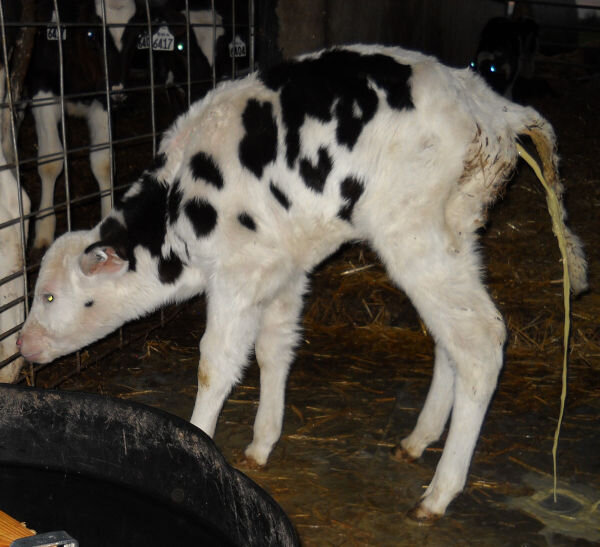Salmonellosis in Cattle
Classic Case
- Age: Can affect neonatal calves, weaned calves, and adult cattle
- Clinical signs vary by age and severity
- Calves (<2 weeks):
- Acute, watery to bloody diarrhea
- Fever, dehydration, lethargy
- Can progress to septicemia or polyarthritis
- Adults:
- Fever, anorexia, drop in milk production
- Diarrhea, sometimes foul-smelling or hemorrhagic
- Abortion, especially in late gestation
- Possible carrier state with intermittent shedding
- Calves (<2 weeks):
Etiology
- Caused by various Salmonella enterica serovars, including:
- S. Dublin (host-adapted in cattle; may cause pneumonia, septicemia)
- S. Typhimurium
- Zoonotic strains can infect humans via contaminated milk or meat
Diagnosis
- Fecal culture: Requires multiple samples for accuracy
- PCR: More rapid, but false positives/negatives possible
- Blood culture: Useful in septicemic calves
- Necropsy findings: Enterocolitis, enlarged mesenteric LNs, necrosis, and fibrin in the intestine
Treatment
- Fluids and electrolyte support are critical
- Antimicrobials: Controversial due to resistance and carrier risk
- Indicated in septicemic animals (often use ampicillin, ceftiofur)
- NSAIDs for fever and inflammation
Prevention
- Biosecurity: Avoid fecal contamination of feed and water
- Vaccination: Available for some serovars (especially S. Dublin)
- Colostrum management in calves
- Proper hygiene in maternity and calf-rearing areas
Zoonotic Risk
- High – especially to farm workers and veterinary staff
- Use of PPE, handwashing, and pasteurization of milk is essential
Salmonellosis in Cattle – A NAVLE Clinical Study Guide
Overview
Salmonellosis, caused by various Salmonella enterica serotypes such as S. Typhimurium, S. Dublin, and S. Newport, manifests in cattle from subclinical to severe septicemic illness. Cattle may excrete Salmonella intermittently, making control challenging and posing a zoonotic risk to farmworkers and consumers through contaminated meat and milk.
Etiology & Transmission
- Common bovine serotypes: S. Typhimurium (calves), S. Dublin (calves and adults), S. Newport
- Transmission predominantly via fecal-oral route; also possible via milk, colostrum, aerosols, or vertical transmission in S. Dublin
- Environmental survival prolonged in moist, warm areas and via contaminated surfaces or equipment (merckvetmanual.com, partners-in-reproduction.com)
Pathogenesis
Following ingestion, Salmonella invades the intestinal mucosa, multiplies, and may cause enteritis or systemic spread. In calves, septicemia can arise rapidly; adults typically develop enteric disease, but S. Dublin can become systemic, causing respiratory signs and abortion (merckvetmanual.com).
Clinical Presentations
Cattle display a wide spectrum:
- Neonatal calf septicemia: acute depression, fever, death within 6–12 hours; diarrhea may follow
- Calf enteritis: watery to mucoid, sometimes hemorrhagic diarrhea, dehydration, poor appetite
- Adult cattle: fever, profuse watery or dysenteric diarrhea, dehydration, reduced milk production, abortion (S. Dublin), chronic pneumonia, arthritis, sloughing of extremities, or sudden death due to endotoxemia (nadis.org.uk)
Diagnosis
- Clinical suspicion: based on typical signs and risk factors
- Lab confirmation via aerobic culture of feces, blood, or milk, or PCR-based detection
- Serology (ELISA) may help detect herd exposure but is less specific (partners-in-reproduction.com)
Differential Diagnoses
Neonatal cases: bacterial (E. coli), viral causes (BVD, rota-, corona-), coccidiosis, cryptosporidiosis
Adults: winter dysentery, Salmonella, Mycoplasma bovis, toxicant ingestion (msdvetmanual.com)

Treatment
- Supportive care: IV fluids for dehydration, NSAIDs for endotoxemia control
- Antimicrobials: parenteral antibiotics targeting gram-negative bacteria (e.g., ampicillin, ceftiofur, trimethoprim-sulfa), based on local sensitivity and regulatory compliance
- Caution: antimicrobial therapy may prolong shedding and create asymptomatic carriers; antimicrobial choice in food animals must align with regulations (merckvetmanual.com)
Prevention & Control
- Practice strict biosecurity: isolate and test new cattle; maintain high hygiene
- Clean and disinfect housing, equipment, feed bunks, and waterers regularly
- Control pests (rodents, birds, flies)
- Manage herd density; minimize stress during transport and calving
- Vaccination: live and bacterin vaccines available for S. Dublin, though efficacy varies; use should be guided by veterinary advice (partners-in-reproduction.com, frontiersin.org)
Zoonotic Risk
Cattle are a recognized reservoir. S. Dublin shows rising multidrug resistance and human disease severity. Farm workers should use protective clothing, gloves, and practice hand hygiene. Pasteurizing milk is essential to reduce human exposure .
NAVLE-Style Multiple-Choice Questions
1. Diagnosis
A 10-day-old calf presents acutely with depression and fever and dies within 8 hours. Necropsy reveals septic lesions in lungs and joints. What is the most likely cause?
A. Clostridium perfringens toxin
B. Enterotoxigenic E. coli
C. Salmonella typhimurium causing septicemia
D. Cryptosporidium parvum
E. Rotavirus
Correct Answer: C
Explanation: Rapid onset septicemia in neonatal calves with systemic signs suggests invasive Salmonella, particularly S. Typhimurium (shiresvets.com, msdvetmanual.com, partners-in-reproduction.com, researchgate.net).
2. Treatment
Adult dairy cow with high fever, sudden diarrhea, dehydration, and anorexia suffers from S. Dublin infection. What is the most appropriate initial therapy?
A. Oral NSAIDs only
B. IV fluids, broad-spectrum antibacterial (e.g., ceftiofur), and NSAIDs
C. Oral probiotics and electrolytes
D. Farmer-managed homeopathy
E. Immediate culling
Correct Answer: B
Explanation: Systemic salmonellosis requires aggressive supportive care and appropriate antibiotics; NSAIDs help control endotoxemia (shiresvets.com, merckvetmanual.com).
3. Prevention
Which practice most effectively prevents spread of salmonellosis in a dairy herd?
A. Increasing dietary fiber for all cows
B. Vaccinating only heifers at weaning
C. Isolating newly purchased animals and disinfecting common areas
D. Adding antibiotics to water troughs for all cattle
E. Mixing age groups to build immunity
Correct Answer: C
Explanation: Controlling bacterial introduction via isolation and sanitation is key; age mixing increases transmission risk (vet.cornell.edu, merckvetmanual.com).
References
- Merck Veterinary Manual – Salmonellosis in Animals
- Merck Veterinary Manual – Salmonella Dublin Infection in Cattle
- NADIS – Salmonellosis in Cattle
- VetCornell – Bovine Herd Salmonellosis Control
- MSD Manual – Differential Diagnoses for Salmonellosis in Cattle
- USDA APHIS – Salmonella on U.S. Beef Cow-calf Operations